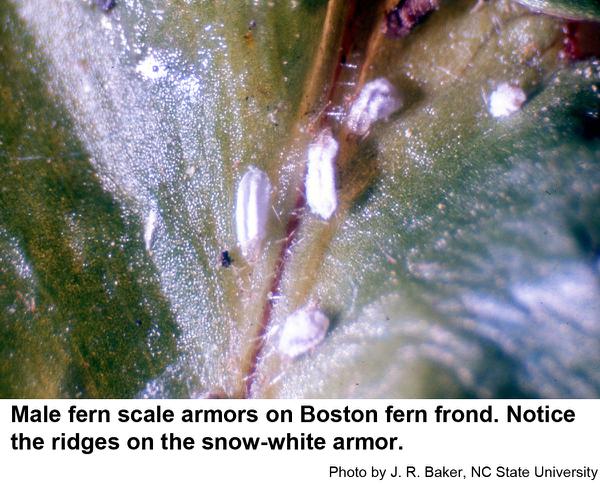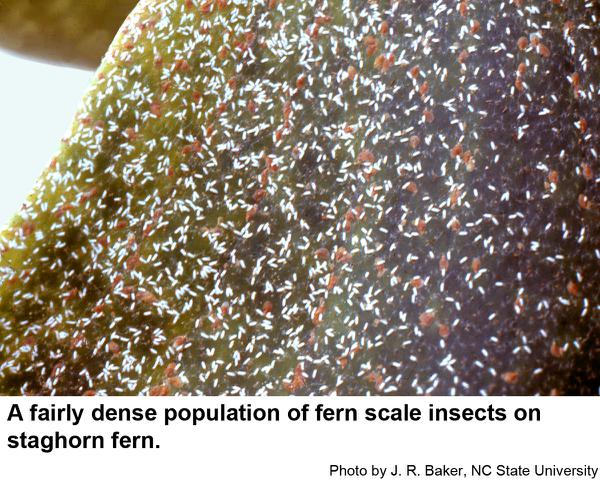Description and Biology
Female fern scales, Pinnaspis aspidistrae, secrete armor that is oystershell or pear shaped, flat, light brown with the crawler cast skin a paler brown at the narrow end. Sometimes the second stage armor is also paler than the adult armor. Female armors are up to 3/16 inch long. The male armor is fluffy white with three ridges. The crawler cast skin is beige to yellowish brown. Adult males emerge from their armor as tiny, two winged, gnatlike insects that are easily overlooked. Eggs are extremely small and are laid in groups under the female armor. Fern scale crawlers are about the size of a grain of pollen, flat, and yellow with red eyes. The legs and antennae are well developed. Female second-stage nymphs begin secreting an oval, pale brown armor that grows to about 1/32 inch long. Mature male second stage armors are about 3/32 inch long. Little is known about the biology of fern scales specifically. In general, female armored scales lay their eggs under the test (armor). The female dies after the last egg is laid. Tiny crawlers hatch from the eggs and eventually emerge from under the mother's armor. The crawlers move about until they begin to feed by inserting their long, threadlike mouthparts into the leaf and sucking out nutrients. The insect molts into a second stage and begins to secrete a waxy material from under the rear of the first stage (crawler) cast skin. Eventually these insects molt into the adult stage. Female scales begin to secrete adult armor at the rear of the second stage armor. Males emerge from their second stage armor as tiny, gnatlike insects that crawl or fly to female scales to mate. The armor remains fastened to the plant long after the scale insect emerges (male) or dies inside (female). When populations become dense, females tend to lay male eggs so that heavily infested plants become conspicuously spotted by second stage male armor.
Host Plants
In North Carolina, fern scales are mainly found infesting true ferns (not asparagus ferns) and liriope. This pest has been recorded from numerous foliage plants, citrus, and other woody ornamental trees and shrubs in Florida and Hawaii. Other host plants include various palms and foliage plants including bird of paradise, Chamaedorea, Chrysalidocarpus, dracaena, ficus, lady palm, mondo, Monstera, Ophiogon, Phoenix roebelenii, staghorn fern, and ti. Infested ferns are most conspicuously disfigured by the presence of male snow-white second stage armors that contrast against dark green foliage. Feeding causes yellow spots on some fern cultivars and on liriope. Males do not feed beyond the second stage of development.
Residential Recommendations
When fern scales are encountered, horticultural oils give adequate control without excessive phytotoxicity to ferns. Two thorough treatments two weeks apart should give good control. Ferns are notoriously sensitive to pesticides. Whenever treating ferns and other sensitive plants, treat at a time that the pesticide will be dry on the foliage before the plants are exposed to full sunlight.
References
- Florida Armored Scale Insects. Dekle, G. W. 1965. Arthropods of Florida and Neighboring Land Areas, Vol 3. 265 pp.
- Insect and Related Pests of Flowers and Foliage Plants. Baker, J. R. ed. 1994 (revised). NC Cooperative Extension Service pub. AG-136.
- NC State Extension Plant Pathology Publications
- NC State Horticultural Science Publications
- North Carolina Agricultural Chemicals Manual
For assistance with a specific problem, contact your local N.C. Cooperative Extension center.
This factsheet has not been peer reviewed.
Publication date: March 3, 2018
Revised: Dec. 8, 2022
Recommendations for the use of agricultural chemicals are included in this publication as a convenience to the reader. The use of brand names and any mention or listing of commercial products or services in this publication does not imply endorsement by NC State University or N.C. A&T State University nor discrimination against similar products or services not mentioned. Individuals who use agricultural chemicals are responsible for ensuring that the intended use complies with current regulations and conforms to the product label. Be sure to obtain current information about usage regulations and examine a current product label before applying any chemical. For assistance, contact your local N.C. Cooperative Extension county center.
N.C. Cooperative Extension prohibits discrimination and harassment regardless of age, color, disability, family and marital status, gender identity, national origin, political beliefs, race, religion, sex (including pregnancy), sexual orientation and veteran status.



